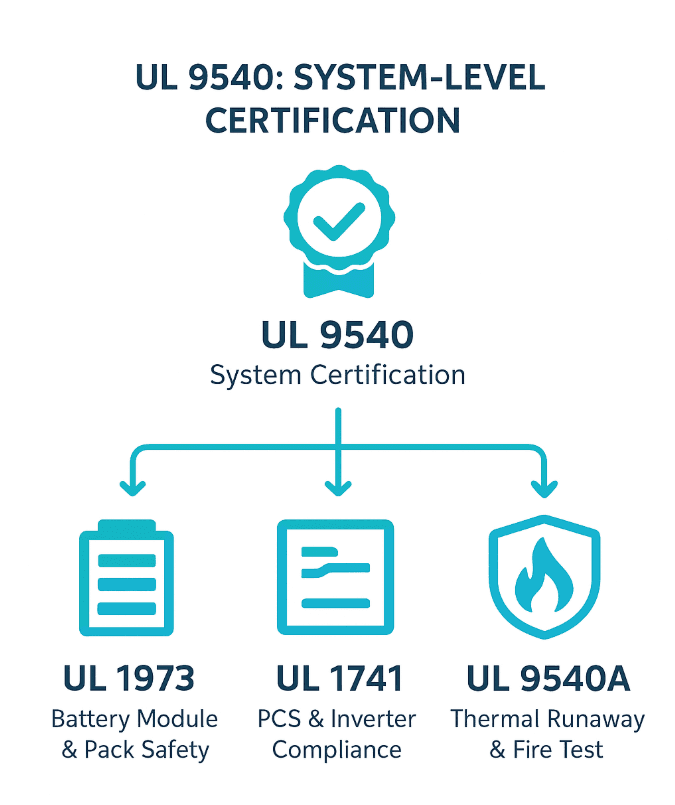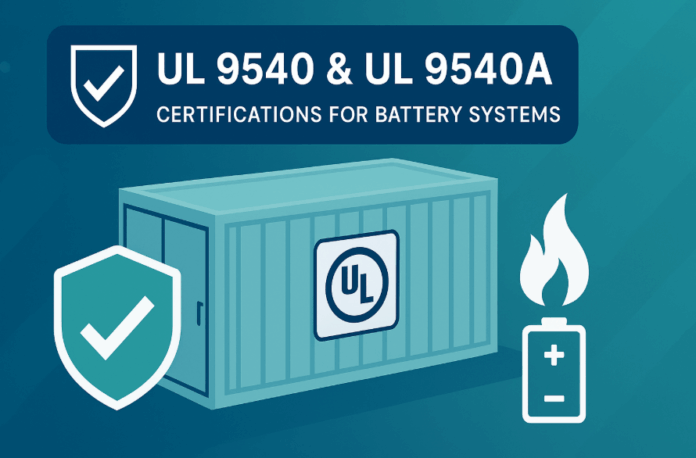UL Certifications for Battery Systems: As renewable energy and battery storage expand worldwide, grid-scale battery energy storage systems (BESS) are becoming critical to grid stability. However, the growing deployment of lithium-ion and other advanced chemistries brings safety challenges such as thermal runaway, fire, and explosion risks.
To address these concerns, standards like UL 9540, UL 9540A, and NFPA 855 provide a structured framework for certification, testing, and installation requirements. Together, they form the backbone of compliance strategies for manufacturers, project developers, and insurers.
This article explores the scope, purpose, and compliance pathways of UL 9540 and UL 9540A, explains their interaction with NFPA 855, and highlights case studies that illustrate best practices for safe BESS deployment.
Understanding UL 9540: The Energy Storage System Safety Standard
UL 9540 is the North American safety certification for complete energy storage systems (ESS). Unlike standards that cover only components (such as UL 1973 for batteries or UL 1741 for inverters), UL 9540 evaluates the integrated system as a whole.
Scope of UL 9540

- Electrical safety – protection against overcurrent, isolation faults, and overcharge.
- Mechanical safety – resilience against vibration, shock, and structural failure.
- Environmental resilience – safe operation under heat, cold, and humidity.
- Fire detection and suppression – verification of built-in detection, alarms, or suppression systems.
- Thermal runaway control – reliance on UL 9540A data to validate containment in large systems.
Certification Process
- Design review with a Nationally Recognized Testing Laboratory (NRTL).
- Type testing of the fully assembled ESS.
- Result evaluation and conditions for installation.
- Factory inspections and ongoing labeling.
UL 9540A: Testing Thermal Runaway Fire Propagation

Testing Hierarchy
- Cell level – forcing a single cell into failure.
- Module level – analyzing propagation within a pack.
- Unit level – testing a complete enclosure or cabinet.
- Installation level – simulating fire across multiple units.
UL 9540A provides data-driven insights rather than a pass/fail result. Authorities Having Jurisdiction (AHJs) and insurers use the test reports to decide whether specific installations meet safety goals.
NFPA 855: The Installation Standard That Ties It All Together
While UL 9540 certifies the product and UL 9540A tests its fire behavior, NFPA 855 is the fire code that governs installation. It sets requirements for:
- Separation distances between units.
- Maximum capacities in certain occupancies.
- Fire detection, suppression, and ventilation.
- Emergency response planning.
Importantly, NFPA 855 requires ESS units to be UL 9540 listed, and it recognizes UL 9540A results as the method for approving performance-based exceptions.
Compliance Strategies for Large-Scale BESS
To achieve compliance, manufacturers and developers typically:
- Use UL 1973-certified battery modules.
- Deploy robust battery management systems (BMS).
- Integrate fire-resistant enclosures and deflagration vents.
- Conduct UL 9540A testing to support tighter spacing or higher energy density.
- Perform Hazard Mitigation Analyses (HMA) for large projects.
Why These UL Certifications Matter for Insurers and Risk Engineers
Insurance underwriters increasingly require UL 9540 and UL 9540A evidence before offering coverage. Benefits include:

- Clear baseline risk assessment.
- Confidence in thermal runaway containment.
- Better terms for facilities with advanced safety systems.
- Stronger liability protection in case of incidents.
Case Studies: Lessons from the Field
- Arizona 2019 Incident – Lack of venting led to an explosion, sparking stricter UL 9540A requirements.
- Utility-Scale Project – Installation-level testing validated a sprinkler-based system, preventing major loss.
- Urban Deployment – A high-rise installation gained approval only after UL 9540A demonstration and strict NFPA 855 compliance.
These examples highlight how certification and testing translate into real-world safety and insurability.
Conclusion: UL Certifications as the Cornerstone of Safe BESS Deployment
UL 9540, UL 9540A, and NFPA 855 together provide the framework for safe, scalable, and insurable energy storage.
For manufacturers and developers, achieving compliance is not optional—it’s essential for market acceptance, regulatory approval, and financial backing.
For insurers and risk engineers, these certifications reduce uncertainty and provide confidence that grid-scale BESS projects are designed with safety at their core.



